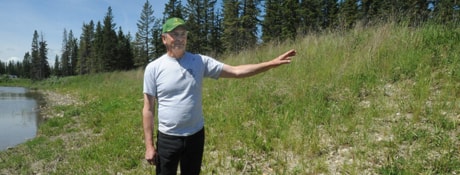SUNDRE — Long-running lobbying efforts for funding to build defences against erosion and flooding from the Red Deer River have paid off with Alberta Environment Minister Rob Renner announcing $2.4 million in aid on Monday.
The low-key announcement was made at Sundre Town Hall, where Renner met with town and county representatives. Earlier in the day, he had taken to the air to view the river’s changing course.
Sundre Mayor Annette Clews was pleased that the province had recognized the community’s plight and the dangers posed by continuing river erosion.
“It is a relief. I know we’ll have a lot of relieved citizens within the town,” said Clews.
Erosion has become a public safety issue because the river is closing in on town sewer lines.
It is hoped that a funding agreement is signed and necessary approvals lined up in time to undertake the anti-erosion work during the winter months so it is in place for next year’s spring runoff.
Last August, the town chose a plan to prevent erosion and safeguard the town. The work was then priced at $2.3 million.
To divert water away from the most vulnerable parts of the riverbank, engineers propose building 14 spurs into the river to slow water flow at those points.
Another bank protection measure involves “armouring” 90 metres of bank with riprap, a barrier typically made from rocks wrapped in wire mesh.
Renner said he and Rocky Mountain House MLA Ty Lund exerted “significant pressure” to free up funding, and the request paid off earlier this month when the Treasury Board approved the grant requested by Municipal Affairs Minister Hector Goudreau.
Public safety figured large in the decision to provide funding, he said, referring to fears erosion could jeopardize the main sewer line.
“If you were to lose that sewer line you’d be dumping raw sewage into the river and the cost would be far more than anything we would spend to do this mitigation now,” he said.
Since more erosion has occurred since the last review of the river was done by engineers, the grant will be flexible enough to cover any new erosion problems that have emerged, said Renner.
Municipal officials and a group formed to lobby the province for funding help called Save Our Sundre have long argued that the project should be considered disaster relief because much of the erosion problems were an offshoot of the 2005 floods, which saw the river overflow its banks in many places along its length.
Mountain View County Reeve Paddy Munro said the river has recently spilled over in a couple of places in the county, in one case entering a channel it hasn’t been in since the 1950s.
Munro was encouraged that the province is listening to the concerns of municipalities.
“I think the most important thing that has happened here today is we have agreed to co-operate.”
Lund said the funding will address the immediate concerns for Sundre. However, the province must also take a look at all rivers and potential trouble spots.
“Provincially, we have to develop some kind of risk matrix so that we understand when these things need to be addressed because if we don’t we’re just going to end up paying when the disaster happens. And it’s a lot more expensive after the fact.”
Renner said the province is developing an overall river management policy and part of it will include assessing flood risk.
The minister also announced that the province intends to pay to have engineers inspect an anti-flooding berm illegally built on the Little Red Deer River by Westward Ho residents Bryce and MarieAnne Schacher following the 2005 flooding.
Last year, provincial officials issued an order demanding that the Schachers hire an engineer to assess the berm and ensure that it is not causing an adverse impact to the environment, public safety or property. The Schachers were given until Aug. 31 to either tear the berm down or complete the assessment.
Residents in the hamlet have battled to preserve the berm, which they believe protected their homes from flooding this spring.
Renner acknowledged the berm has local support, but without knowing how it was constructed and whether it offers long-term protection residents may have been left with a “false sense of security.”
Also, allowing the berm, which was built without permits or inspections, could open the province to liability.
The province will foot the $80,000 to $100,000 bill for the engineering inspection.
pcowley@www.reddeeradvocate.com
